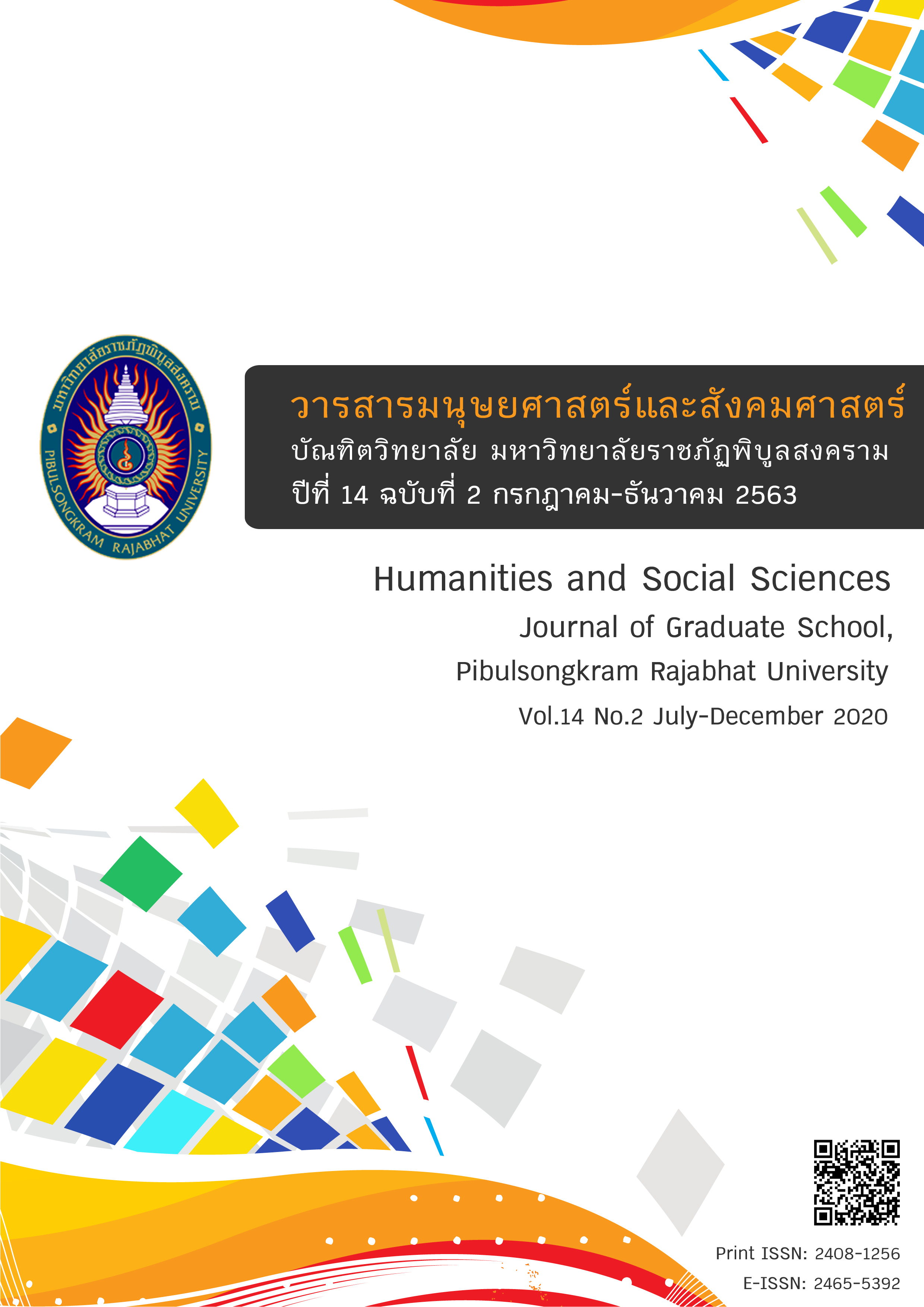การพัฒนารูปแบบการสอนทักษะการพูดภาษาอังกฤษเพื่อการสื่อสารแบบเน้น ภาระงานร่วมกับการใช้สื่อสังคมออนไลน์เพื่อเสริมสร้างความสามารถในการพูดภาษาอังกฤษสำหรับนักศึกษาปริญญาตรี
คำสำคัญ:
การสอนแบบเน้นภาระงาน, ทักษะการพูดภาษาอังกฤษเพื่อการสื่อสาร, สื่อสังคมออนไลน์บทคัดย่อ
การวิจัยครั้งนี้มีวัตถุประสงค์เพื่อ 1) เพื่อสำรวจหัวข้อความต้องการในการใช้ภาษาอังกฤษในการด้านทักษะการพูดภาษาอังกฤษเพื่อการสื่อสารในงานโรงแรม สำหรับพนักงานส่วนหน้าที่ใช้มากที่สุด 2) เพื่อพัฒนารูปแบบการสอนแบบเน้นภาระงาน ร่วมกับการใช้สื่อสังคมออนไลน์ เพื่อเสริมสร้างทักษะการพูดภาษาอังกฤษเพื่อการสื่อสาร ให้มีประสิทธิภาพ 3) เพื่อศึกษาพัฒนาการด้านการพูดภาษาอังกฤษเพื่อการสื่อสาร โดยใช้รูปแบบการสอนในแต่ละหน่วยการเรียนรู้ 4) เพื่อศึกษาความพึงพอใจของนักศึกษาต่อรูปแบบการสอนที่พัฒนาขึ้น ผลการวิจัยพบว่า 1) พนักงานส่วนหน้ามีหัวข้อความต้องการในการใช้ภาษาอังกฤษด้านทักษะการพูดภาษาอังกฤษจำนวน 6 หัวข้อ 2) รูปแบบการสอนมีประสิทธิภาพสูงกว่าร้อยละ 70 3) รูปแบบมีประสิทธิผล คือ หลังการทดลองใช้รูปแบบนักศึกษามีพัฒนาการเท่ากับร้อยละ 74.21 มีเกณฑ์ระดับพัฒนาการอยู่ในพัฒนาการระดับสูง และ 4) นักศึกษามีความพึงพอใจต่อรูปแบบการสอน (LOVE Model) โดยภาพรวมอยู่ในระดับพึงพอใจมาก
เอกสารอ้างอิง
กระทรวงการท่องเที่ยวและกีฬา. (2554). แผนพัฒนาการท่องเที่ยวแห่งชาติ พ.ศ. 2555-2559. กรุงเทพฯ: กระทรวงการท่องเที่ยวและกีฬา.
กระทรวงศึกษาธิการ. (2547). ปฏิรูปการศึกษายุคใหม่. กรุงเทพฯ: องค์การรับส่งสินค้าและพัสดุภัณฑ์.
กฤษณา สิกขมาน. (2555). รายงานการวิจัยเพื่อพัฒนาการเรียนการสอน การศึกษาผลสัมฤทธิ์ทางการเรียนรายวิชาการสื่อสารภาษาอังกฤษธุรกิจ โดยการใช้การสอนแบบ E-learning. กรุงเทพฯ: มหาวิทยาลัยศรีปทุม.
เขมณัฏฐ์ มิ่งศิริธรรม. (2556). Social Media สื่อสร้างสรรค์เพื่อการศึกษา. Veridian E-Journal. Su, 6(1), 72-81.
ชุติมา กองถัน. (2556). การพัฒนาทักษะการพูดภาษาอังกฤษเพื่อการท่องเที่ยวโดยใช้ชุดภาพประกอบการบรรยายแนะนำแหล่งท่องเที่ยวและสถานการณ์จำลองในจังหวัดเพชรบูรณ์ สำหรับนักศึกษามหาวิทยาลัยเพชรบูรณ์. Retrieved October 10, 2019, from http://reserach.pcre.ac.th/rdb/pro_data/file/hmp39.pdf
ทิศนา แขมมณี. (2550). ศาสตร์การสอน: องค์ความรู้เพื่อการจัดกระบวนการการเรียนรู้ที่มีประสิทธิภาพ. กรุงเทพฯ: จุฬาลงกรณ์มหาวิทยาลัย.
ธีรพงษ์ สุภักดี. (2550). การบริหารการเปลี่ยนแปลงในศตวรรษที่ 21. กรุงเทพฯ: มิตรสยามการพิมพ์.
พรพงศ์ ศิริสุขเจริญพร. (2560). การพัฒนาการเรียนการสอนผ่านเว็บ วิชาเทคโนโลยีคอมพิวเตอร์ในงานอุตสาหกรรม. วารสารวิชาการมหาวิทยาลัยธนบุรี, 11(26), 24-30.
ระวิ แก้วสุกใส และชัยรัตน์ จุสปาโต. (2556). เครื่อข่ายสังคออนไลน์ กรณี เฟซบุ๊ก กับการพัฒนาผู้เรียน. วารสารมหาวิทยาลัยนราธิวาสราชนครินทร์, (ฉบับพิเศษประจำปี 2556), 195-203.
สภาอุตสาหกรรมการท่องเที่ยวแห่งประเทศไทย. (2553). “ดัชนีความเชื่อมั่นของผู้ประกอบธุรกิจการท่องเที่ยวแห่งประเทศไทย” รายงานประจำปี. กรุงเทพฯ: สภาอุตสาหกรรมการท่องเที่ยวแห่งประเทศไทย.
สริตา บัวเขียว. (2550). การออกแบบและพัฒนารายวิชาภาษาอังกฤษธุรกิจโดยยึดแหล่งการเรียนรู้ เป็นฐานสำหรับนักศึกษาปริญญาตรี มหาวิทยาลัยราชภัฎเพชรบุรี (วิทยานิพนธ์ปรัชญาดุษฎีบัณฑิต). มหาวิทยาลัยเกษตรศาสตร์, กรุงเทพฯ.
สุภิตา กาฬสินธุ์ และนิสากร จารุมณี. (2558). ความจำเป็นในการใช้ภาษาอังกฤษของพนักงานต้อนรับส่วนหน้าของโรงแรมในพื้นที่ท่องเที่ยวภาคใต้ของประเทศไทย ในการเข้าสู่ประชาคมอาเซียน ปี พ.ศ. 2558. สืบค้น 5 เมษายน 2563, จาก https://www.tcithaijo.org/index.php/rpu/article/view/112621
สุรีย์วรรณ ฉัตรอนันทเวช. (2537). ผลของกิจกรรมฟัง-พูดภาษาอังกฤษ สำหรับนักศึกษาการท่องเที่ยวและการโรงแรม โดยการใช้การปฏิสัมพันธ์ระหว่างนักเรียนในห้องเรียน (วิทยานิพนธ์ศิลปศาสตรมหาบัณฑิต). มหาวิทยาลัยเกษตรศาสตร์, กรุงเทพฯ.
สุวรรณา ยุทธภิรัตน์. (2559). การใช้ภาษาอังกฤษของพนักงานส่วนหน้าของโรงแรมอิสระในกรุงเทพมหานคร. กรุงเทพฯ: มหาวิทยาลัยนอร์ทกรุงเทพ.
สำนักงานเลขาธิการสภาการศึกษา. (2560). แผนการศึกษาแห่งชาติ ฉบับปรับปรุง พ.ศ. 2560-2579. กรุงเทพฯ: พริกหวานกราฟฟิค.
อัฉรา วงศ์โสธร และคณะ. (2546). สำรวจสภาพความต้องการใช้ภาษาอังกฤษของสังคมระดับมาตรฐานและคุณภาพที่สังคมต้องการสำหรับนิสิต/นักศึกษาทำสำเร็จการศึกษาในระดับปริญญาตรี (รายงานผลวิจัย). กรุงเทพฯ: งบประมาณแผ่นดิน สถาบันภาษา จุฬาลงกรณ์มหาวิทยาลัย.
Bailey, K., & Savage, L. (1994). New ways in teaching speaking. Alexandria, VA: TESOL.
Bosher, S., & Smalkoski, K. (2002). From needs analysis to curriculum development: designing a course in health-care communication for immigrant students in the USA. English for Specific Purposes, 21(2002), 59-79.
Brumfit, C. (1984). Communicative methodology in language teaching. The roles of fluency and accuracy. England: Cambridge University Press.
Bygate, M. (1999). Task as context for the framing, re-framing and un-framing of language. System, 27, 33-48.
Cambridge English. (2016) .Preliminary for Schools. South England: Official Cambridge English exam preparation materials.
Ellis, M., & Christine, J. (1994). Teaching business English. Oxford: Oxford University Press.
Ellis, R. (1984). Classroom second language development. Oxford: Pergamon.
Ellis, R. (2003). Task-based language learning and teaching. Oxford: Oxford University Press.
Johnson, K., & Morrow, K. (1981). Communication in the classroom. Harlow: Longman.
Johnson, R. (1994). Learning together and alone, Cooperative, competitive, and individualistic learning. Needham Heights. MA: Prentice-Hall.
Leslie, D., & Russell, H. (2006). The importance of foreign language skills in the tourism sector: A comparative study of student perceptions in the UK and continental Europe. Tourism management, 27(6), 1397-1407.
Littlewood, W. (1995). Communicative language teaching. England: Cambridge University Press.
Mackay, R., & A. Mountford. (1978). English for specific purposes. London: Longman.
McCombs, B. L. (2000). Assessing the role of educational technology in the teaching and learning process: A Learner-centered perspective. Paper presented at the meeting of the Secretary’s Conference on Educational Technology: Measuring the Impacts and Shaping the Future. Washington, D. C.
Nunan, D. (2004). Task-Based language teaching. England: Cambridge University Press.
Pica, T., Kang., H., & Falodun, J. (1993). Choosing and using communication tasks for second language instruction. In G. Crookes & S. Gass (Eds.), Tasks and second language learning (9-34) Clevdon, UK: Multilingual Matters.
Richard, J., & Rodgers, S. (2001). Approaches and methods in language teaching: A description and analysis. England: Cambridge University Press.
Sarkis, R. (2012). Using cognitive strategies to improve English speaking skill and self-confidence. American Journal of Education Science.
Strevens, P. (1988). New orientations in the teaching of English. London: Morrisonand Cibb.
Tribolet, C. (2012). Using cognitive strategies to improve English speaking skill and self-confidence. American Journal of Education Science. 2(3), 36-40.
Tsao, C. H. (2011). English for specific purposes in the EFL context: A survey of student and faculty perception. Asian ESP Journal, 7(1833-2994), 125-148.
William, W. (1995). Teaching English as a second language. London: Longman Press.
Willis, J. (1996). A framework for task-based learning. Harlow: Longman.
ดาวน์โหลด
เผยแพร่แล้ว
รูปแบบการอ้างอิง
ฉบับ
ประเภทบทความ
สัญญาอนุญาต
บทความหรือข้อคิดเห็นใดใดที่ปรากฏในวารสารมนุษยศาสตร์และสังคมศาสตร์ มหาวิทยาลัยราชภัฏพิบูลสงครามเป็นวรรณกรรมของผู้เขียน ซึ่งบรรณาธิการไม่จำเป็นต้องเห็นด้วย บทความที่ได้รับการตีพิมพ์เป็นลิขสิทธิ์ของวารสารมนุษยศาสตร์และสังคมศาสตร์ มหาวิทยาลัยราชภัฏพิบูลสงคราม









